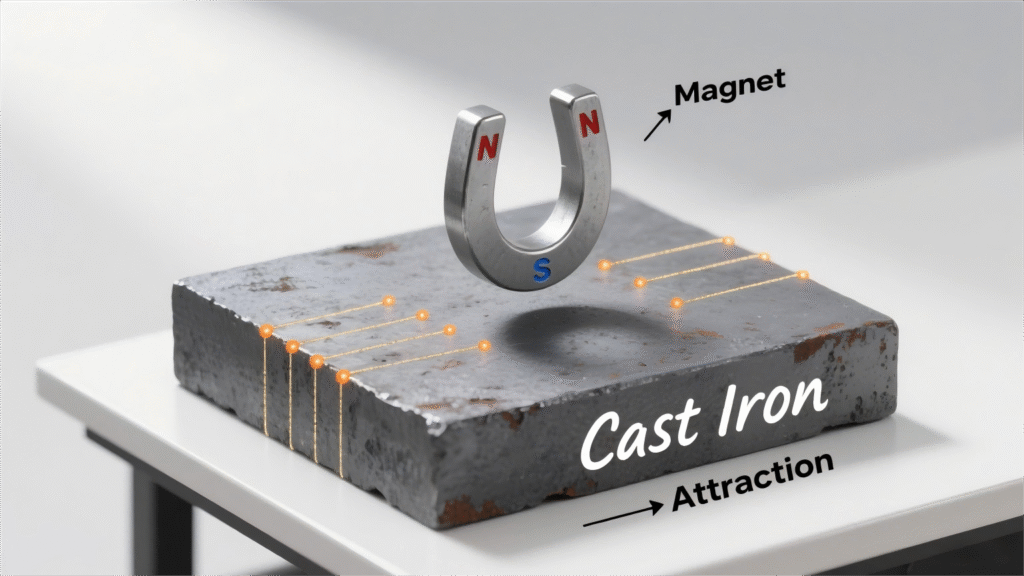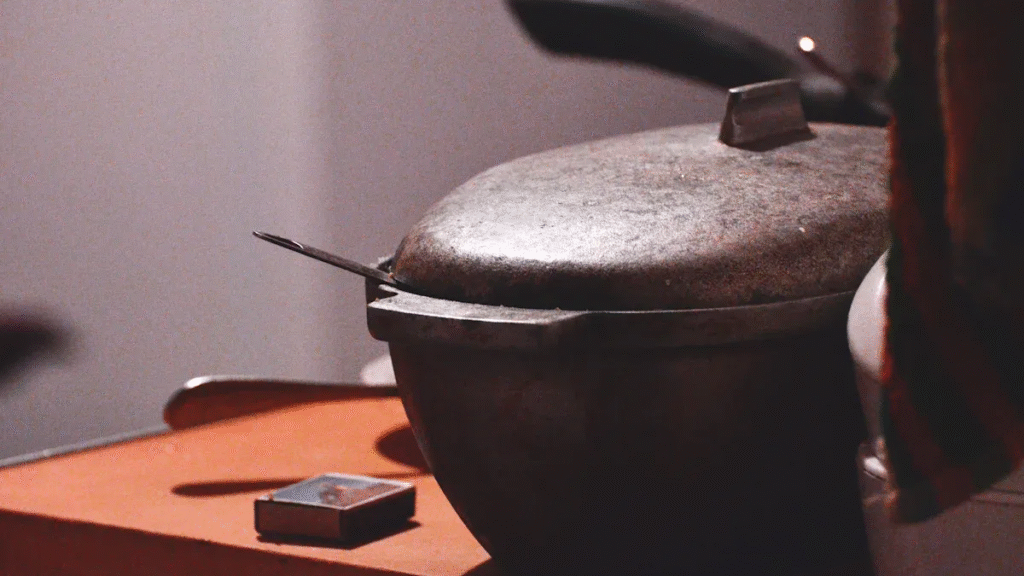Yes, a magnet will stick to cast iron. This is because cast iron has a lot of iron in it. Iron makes cast iron very magnetic. Scientists say that cast iron is ferromagnetic. Unpaired electrons line up and make the magnet stick. If you ask, “is cast iron magnetic?” or “will a magnet stick to cast iron?”, the answer is yes. You can see the high iron amount in different cast iron types below.Lorem ipsum dolor sit amet, consectetur adipiscing elit. Ut elit tellus, luctus nec ullamcorper mattis, pulvinar dapibus leo.
Table of Contents
Main content
- Magnets stick to cast iron because it has a lot of iron. This makes it very magnetic.
- Different cast iron types have different magnetism. This is because of their carbon and structure. White cast iron is the most magnetic.
- Rust and high heat can make cast iron less magnetic. Keeping it clean helps magnets stick better.
- All cast iron cookware is magnetic. This includes enameled cookware. It works well on induction cooktops.
- You can test cast iron’s magnetism at home with a fridge magnet. This helps you pick the right cookware or metal for your needs.
Magnetism of Cast Iron

Why Magnet Stick to Cast Iron
You may ask why a magnet sticks to cast iron. The reason is in how magnetism works. Cast iron has many iron atoms inside. Each iron atom has some unpaired electrons. These electrons act like tiny magnets. They make small groups called magnetic domains. In pure cast iron, these domains line up when a magnet is near. This makes the magnet stick to the metal.
Cast iron has a lot of iron, usually more than 90%. This high iron amount makes magnetism strong. When you ask if cast iron is magnetic, you are asking about these iron atoms. More iron means more magnetic domains. That is why pure cast iron is very magnetic.
- Iron’s atomic structure gives it special magnetic powers:
- Unpaired electrons in iron atoms make magnetic moments.
- These moments point the same way in magnetic domains.
- The body-centered cubic structure helps domains form.
- Cast iron’s high iron keeps these domains working.
- Pure cast iron is most magnetic because it has few impurities.
Tip: To test cast iron’s magnetism at home, use a fridge magnet. You will see it stick right away.
Add Your Heading Text Here
Cast iron is a ferromagnetic material. This means it has a strong kind of magnetism. In pure cast iron, unpaired electrons in iron atoms spin the same way. This spin makes strong magnetic domains. When a magnet is close, these domains line up with the magnet. That is why a magnet sticks to cast iron so well.
Cast iron’s magnetism depends on how the domains act. In pure cast iron, the domains are big and easy to line up. This makes the magnetism strong. If you ask if cast iron is magnetic, the answer is yes because of these domains. Carbon and other elements can break up the domains. This can make the magnetism weaker, but most cast iron still attracts a magnet.
Scientists use tests to check cast iron’s magnetic properties. They use rules like ASTM A34 to prepare samples. They also use machines to send signals through the metal. These machines measure how the domains react. These tests show pure cast iron is very magnetic. The tests also show how carbon and other elements change the magnetism.
You can see cast iron’s magnetism every day. Try a magnet on a cast iron pan. The magnet will stick because of the domains inside. Pure cast iron pans show the strongest effect. If you wonder if cast iron is magnetic, remember the science of domains and unpaired electrons.
| Feature | Pure Cast Iron | Cast Iron with More Carbon |
|---|---|---|
| Iron Content | High | Slightly Lower |
| Magnetic Domains | Large, Aligned | Smaller, Sometimes Broken |
| Magnetism | Strong | Can Be Weaker |
| Magnet Stick | Yes | Usually Yes |
Cast iron’s magnetism comes from its atomic structure. It also comes from how unpaired electrons spin and how domains line up. Pure cast iron is the best example of this. When you see a magnet stick to cast iron, you are seeing magnetism in action.
Types of Cast Iron
Magnetic Behavior of Different Types
Not every cast iron acts the same with a magnet. Each type has its own structure. This changes how it reacts to magnets. The way carbon is found in cast iron matters a lot. Some types let magnetic domains line up well. Others stop the domains from lining up.
| Type of Cast Iron | Carbon Content (%) | Magnetic Behavior |
|---|---|---|
| White Cast Iron | 1.8 – 3.6 | Magnetic due to iron carbide presence |
| Gray Cast Iron | 2.5 – 4.0 | Weakly magnetic or non-magnetic due to graphite flakes disrupting magnetic domains |
| Malleable Cast Iron | 2.0 – 2.6 | Weakly magnetic due to tempered carbon |
| Ductile Cast Iron | 3.2 – 4.1 | Weakly magnetic or non-magnetic due to carbon nodules |
White cast iron is strongly magnetic. Iron carbide helps the domains line up. This keeps magnetism strong. Gray cast iron has graphite flakes. These flakes break up the domains. So, gray cast iron is weakly magnetic or not magnetic at all. Malleable and ductile cast iron are also weakly magnetic. Their carbon forms nodules or special shapes. These shapes block the domains from lining up.
Note: Most cast iron will still attract a magnet. But how strong it is depends on the type and structure.
Alloy Variations
Adding other elements can change cast iron’s magnetism. Silicon, manganese, and chromium are often added. Each one changes the magnetic properties in its own way.
- Silicon makes cast iron stronger and more magnetic.
- Manganese makes cast iron tougher and changes its structure.
- Chromium makes cast iron harder and stops rust, but can change magnetism.
Some special cast iron alloys have nickel and chromium. These alloys have a different structure. They may not be very magnetic. The microstructure and carbon shape matter a lot for magnetism.
Here is a table showing how these elements affect cast iron:
| Alloying Element | Effect on Magnetism and Related Properties in Cast Iron |
|---|---|
| Silicon | Increases magnetic permeability and strength |
| Manganese | Changes microstructure, may affect magnetic behavior |
| Chromium | Alters hardness and corrosion resistance, can affect magnetic properties |
When you test different cast iron alloys, most will still attract a magnet. The strength of magnetism depends on the type and what is inside. If you want to check at home, use a magnet on different cast iron objects. You will see the magnet sticks better to some types than others. But almost all cast iron will attract a magnet.
Factors Affecting Magnetism
Composition and Carbon Content
Some cast iron is more magnetic than others. This depends on what is inside the cast iron. The amount of carbon and other elements can change magnetism. More carbon in cast iron usually means less magnetism. Carbon changes the inside structure of the metal. For example, gray cast iron has lots of carbon and graphite flakes. This makes it weakly magnetic. White cast iron has less carbon and a different structure. It is much more magnetic. Ductile cast iron has carbon in round shapes called nodules. It is less magnetic than gray cast iron.
- More carbon means magnets do not stick as well.
- Gray cast iron is weakly magnetic because of graphite flakes.
- White cast iron is very magnetic because of its structure.
- Carbon also changes the Curie temperature, where magnetism goes away.
The magnetic strength of cast iron depends on what it is made of. If you want strong magnetism, pick cast iron with less carbon.
Temperature and Rust
Heat can change how magnetic cast iron is. When you heat cast iron, the magnetic parts move around. If it gets too hot, past the Curie temperature, it loses magnetism. A magnet will not stick until the metal cools down.
Rust can also change how magnets stick to cast iron. Most rust on cast iron is red rust. Red rust is not magnetic. It forms a layer between the magnet and the metal. This makes the magnet weaker and not stick as well. Sometimes, black rust forms instead. Black rust is magnetic and can help a magnet stick better. But red rust is more common and usually makes magnetism weaker.
| Factor | Effect on Magnetism in Cast Iron |
|---|---|
| High Carbon | Lowers magnetism, weak magnetic behavior |
| Low Carbon | Increases magnetism, strong magnetic effect |
| High Temperature | Reduces or removes magnetism |
| Red Rust | Blocks magnetism, weakens magnetic attraction |
| Black Rust | Maintains or improves magnetic adherence |
Tip: To test magnetism at home, use clean cast iron. Take off any red rust first for best results.
Cast Iron Cookware and Magnets

Will a Magnet Stick to Cast Iron Cookware
You might wonder if a magnet will stick to your cast iron cookware at home. The answer is yes. All cast iron cookware, including enameled types, is magnetic because the core material is always cast iron. The enamel coating on some pans does not change the magnetic properties. You can trust that every brand and style of cast iron cookware will show strong magnetism.
If you want to check the magnetism of your cookware, try this simple test:
- Take a fridge magnet or any strong magnet.
- Place it on the bottom of your cast iron pan or pot.
- If the magnet sticks firmly, your cookware is magnetic and ready for induction cooking.
This test works for both bare and enameled cast iron. You do not need to look for special symbols or labels. The magnet test gives you a quick answer.
Tip: Always test on a clean, dry surface. Rust or food residue can weaken the magnetic pull.
Induction Cooking Uses
Induction cooktops need cookware with strong magnetic properties. Cast iron meets this need perfectly. The iron in cast iron reacts with the magnetic field from the induction burner. This reaction heats the cookware quickly and evenly. You get fast, efficient cooking every time.
Here are some reasons why cast iron works so well on induction cooktops:
- Cast iron is a ferrous metal, so it is naturally magnetic.
- The thick base of cast iron pans helps spread heat evenly.
- Cast iron is tough and lasts for many years.
- You can use cast iron for frying, baking, simmering, and more.
When you use cast iron on an induction stove, remember a few safety tips:
- Preheat slowly to avoid thermal shock.
- Match the pan size to the burner for best results.
- Lift the pan instead of sliding it to protect the glass surface.
Cast iron pans are usually thick, often more than 5mm. This thickness helps with heat retention but can place the cooking surface farther from the induction coil. Even so, the magnetism remains strong enough for great cooking results.
Magnets stick to cast iron because it has a lot of iron. Cast iron is ferromagnetic, so magnets are attracted to it. Most cast iron, like pans, is strongly magnetic. If you know about cast iron’s magnetic and mechanical features, you can pick the best type for your needs. Try using a magnet at home to see how it works.
Learning about cast iron helps you make good choices. You can use this knowledge for cooking, building, or helping the environment.
| Cast Iron Type | Magnetic Property | Key Mechanical Properties | Practical Applications |
|---|---|---|---|
| Gray Cast Iron | Strongly magnetic | Easy to machine, reduces vibration | Used for pans, engine blocks, pipes |
| White Cast Iron | Weakly magnetic | Very hard, resists wear | Used for crushing and grinding tools |
| Ductile Cast Iron | Strongly magnetic | Tough and bendable | Used in cars and buildings |
| Malleable Cast Iron | Strongly magnetic | Bends well, strong | Used for tools, brackets, and parts |
| Environmental Impact Category | Magnetic Cast Iron (RE-free) | Nd–Fe–B Magnets (Rare Earth) |
|---|---|---|
| Climate Change (CO2-eq emissions) | About 87% less impact | Highest effect |
| Acidification | Much lower effect | Much higher effect |
| Raw Material Supply Issues | Some issues (like with Mn) | Big problems (rare earth mining) |
Cast iron is useful and better for the planet than rare earth magnets. You can use cast iron in many ways and help the earth too.
FAQ
Will a magnet stick to all types of cast iron?
You will find that most cast iron types attract a magnet. Some types, like gray or ductile cast iron, may show weaker magnetism. The carbon structure inside the metal changes how strong the magnet sticks.
Can rust stop a magnet from sticking to cast iron?
You may notice that red rust can block a magnet from sticking well. Red rust forms a layer that weakens the magnetic pull. Clean the surface for the best results when testing magnetism.
Is cast iron safe to use on induction cooktops?
You can safely use cast iron on induction cooktops. The iron in the cookware reacts with the induction field. This makes cast iron a great choice for fast and even heating.
How can I test if my cookware is cast iron?
You can use a fridge magnet to test your cookware. Place the magnet on the bottom of the pan. If it sticks firmly, your cookware is likely cast iron and works on induction stoves.


